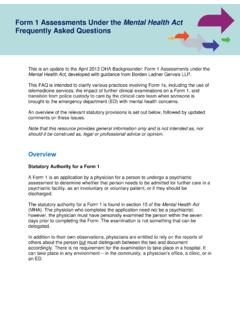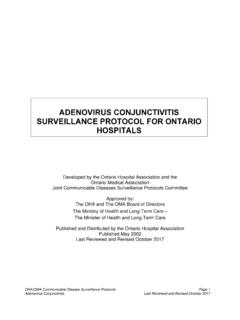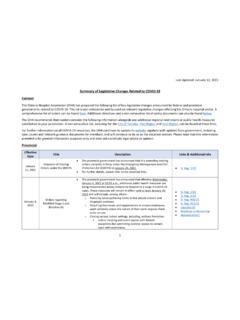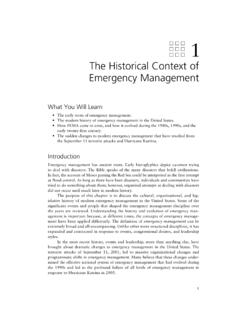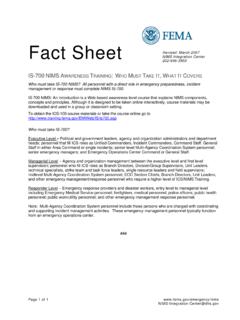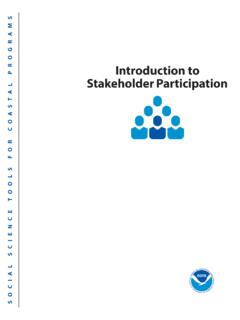Transcription of OHA Emergency Management Toolkit
1 OHA Emergency Management ToolkitDeveloping a Sustainable Emergency Management Program for HospitalsCODE BlACkEMErgEnCy COlOur CODE liSTCODE OrAngE Code Orange CBrnCODE grEEn Code green STATCODE BluECODE PurPlECODE yEllOW Code Amber CODE BrOWnCODE rED CODE Pink CODE grEy Code grey Button-down CODE WHiTEMissing PersonMissing Child/Child AbductionDisasterCBrn DisasterFireViolent/Behavioural SituationCardiac Arrest/Medical Emergency - AdultEvacuation (Precautionary) Evacuation (Crisis)Cardiac Arrest/Medical Emergency - infant/Childin-facility Hazardous SpillHostage TakingBomb Threat/Suspicious ObjectForewordOver the past five years, Ontario s hospitals have made great strides in preparing for emergencies.
2 From applying the lessons learned during the Severe Acute Respiratory Syndrome (SARS) outbreak, to improving collaboration to hosting and participating in training and education initiatives, hospitals are now better prepared to meet the demands of a large-scale Emergency . To support hospitals in their Emergency preparedness efforts, the Ontario Hospital Association (OHA) has developed the OHA Emergency Management Toolkit : Developing a Sustainable Emergency Management Program for the Hospital. The Toolkit includes practical tools, templates, and strategies to assist hospitals with the development and implementation of their Emergency Management Program.
3 Ontario hospitals are committed to quality improvement, and work hard to ensure the safety and protection of their patients, visitors and staff. Emergencies are prevented on a daily basis because of the extensive work hospitals do to mitigate their risks. With this Toolkit , the OHA is helping hospitals further strengthen their ability to plan for and respond effectively to future emergencies. Tom Closson President and CEO Ontario Hospital Association IIID isclaimerThis Toolkit has been prepared by the Ontario Hospital Association (OHA), as a general guide to assist hospitals in their Emergency preparedness and response efforts.
4 The materials in this Toolkit are for general information purposes only and should be adapted to the circumstances of each hospital that uses it. The Toolkit reflects the interpretations and recommendations regarded as valid when it was published based upon available information at that time. This Toolkit is not intended as professional advice or opinion and users are encouraged to seek their own professional advice and opinion in the development of their institution s program and specific plans. The Toolkit is not intended to be the hospital s Emergency Management program, but can serve as a planning guide to assist the hospital in developing and updating such a program.
5 The OHA will not be held responsible or liable for any harm, damage or other losses resulting from reliance of the use or misuse of the general information contained in this Toolkit . Copyright 2008 by Ontario Hospital Association, all rights reserved. This Toolkit is published for OHA members. All rights reserved. No part of this publication may be reproduced stored in a retrieval system, or transmitted in any form by any means, electronic mechanical, photocopying, recording, or otherwise, except for the personal use of OHA members, without prior written permission of the informationCopies of the OHA Emergency Management Toolkit are available for purchase by contacting the Ontario Hospital Association (OHA) by email telephone (416-205-1300), or by using our online ordering system at under OHA Knowledge Management Centre (ISBN 978-0-88621-328-2).
6 OHA Members can access additional copies of the Toolkit via the Internet at by using their Member login and password information. IVPrefaceThe OHA Emergency Management Toolkit : Developing a Sustainable Emergency Management Program for Hospitals ( Toolkit ) was developed in response to a need expressed by Ontario s hospitals to have a province-wide hospital Emergency preparedness and response framework to further hospital readiness in addressing emergencies of all types. This Toolkit will recommend elements of the Emergency Management Program framework for hospitals, which includes a response framework, standardized Emergency Colour Codes, and strategies, tools, and how to information for assisting hospitals with implementation in their facility.
7 How the Toolkit was Developed A. Ontario Hospital AssociationThe Toolkit was approved and has been fully supported by the OHA s Health Emergency Management Committee (HEMC), convened by the OHA to provide strategic direction post-Severe Acute Respiratory Syndrome (SARS) on hospital Emergency preparedness, with membership including hospital administration and clinical staff. The OHA also worked with members and others involved in Emergency preparedness and Management and is grateful to them for sharing tools and templates, reflective of the great planning efforts Working Group SupportThe OHA convened a Working Group with 13 individuals from hospitals and the broader health care sector, with regional and functional role representation, to assist in developing focused objectives for the Toolkit s chapters and to provide subject matter Resources The Toolkit incorporates several standards, reports.
8 And guidance material related to Emergency preparedness and response recommendations including:Canadian Standards Association (CSA) Standard on Emergency Management and Business Continuity Programs CAN-CSA-Z1600 Canadian Standards Association (CSA) Emergency Preparedness and Response Standard CAN-CSA-Z731-03 Canadian Standards Association (CSA) Risk Management : Guideline for Decision-makers CAN-CSA-Q850-97 The Accreditation Canada Program 2009 Standards For the Public s Health: A Plan of Action (Walker Report in 2004)Interim and Final Commission to Investigate the Introduction and Spread of SARS Reports (2006) VWho is the Target Audience?
9 The OHA represents a broad and diverse audience that includes membership of small hospitals, community hospitals, and acute and teaching hospitals. In developing the Toolkit , the OHA set out to design something that would meet the needs of all of these hospitals and also provide considerations for those members providing specialty level care ( , complex continuing care and mental health and rehabilitation). The Toolkit has been organized to target recommendations and provide guidance to two specific audiences: the senior leadership and the Emergency preparedness lead.
10 There are 159 hospital corporations in Ontario. Shown above are: Chatham kent Healthcare Alliance, norh Bay general Hospital and The Ottawa Hospital. VIHow to read the ToolkitThe Toolkit outlines the context for Emergency preparedness and response in hospitals and provides further details based on the target audience. Se Cti On 1: SE ni Or lEADErSHiP This section targets the senior leadership level in the hospital, and outlines what those accountable and leading the facility need to know and do to begin and support the process, set priorities, and sustain a hospital Emergency Management program.
